
Fairly late in my life I’ve come to think about how many trees have marked important times and events in my progression towards the grave. Almost from the time of my earliest memories, specific individual trees have had special significance thanks to their associations with what I was, what I do, what and who I am, and what I will someday become.
THE KINGSBRIDGE ELM
Of all trees the earliest I can clearly remember is an American Elm in my back yard in the Kingsbridge section of New York City. I wish I had a picture of this tree but the only one that exists is in my memory: it was stately and elegant, with multiple trunks, as is the way of American Elm trees. It’s why they were chosen to line streets; but many a town has an “Elm Street” that hasn’t seen an elm in 50+ years.

The house in which I grew up was built in the mid- to late 1880’s; I’ve told its story elsewhere. The original owner kept a horse and carriage, so there was a stable on the lot. In one corner of the stable 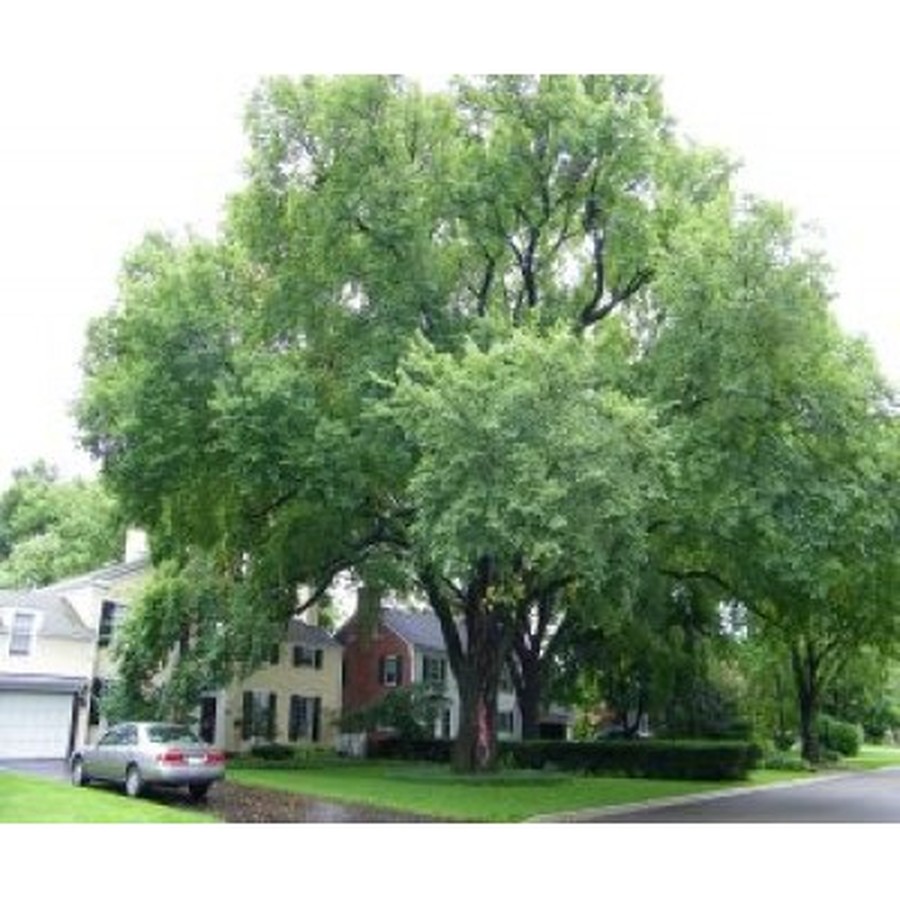 yard someone—presumably the first owner—had planted that American Elm. Since in the 19th Century elms were very popular shade trees it’s no surprise that he chose one. They grow fast: by the time I was old enough to remember the tree (sometime in the early 1950’s) it was easily six feet through at the base and well over fifty feet tall. When I was not quite ten years old I asked my father to hang a tire in the tree to make a swing and spent many hours enjoying that bit of rudimentary “playground equipment” which today would likely contravene some sort of silly ordinance, and installation of which would probably be regarded as “child abuse” in some places; but in 1956 the rampant stupidity that affects too many aspects of American society today hadn’t yet taken hold.
yard someone—presumably the first owner—had planted that American Elm. Since in the 19th Century elms were very popular shade trees it’s no surprise that he chose one. They grow fast: by the time I was old enough to remember the tree (sometime in the early 1950’s) it was easily six feet through at the base and well over fifty feet tall. When I was not quite ten years old I asked my father to hang a tire in the tree to make a swing and spent many hours enjoying that bit of rudimentary “playground equipment” which today would likely contravene some sort of silly ordinance, and installation of which would probably be regarded as “child abuse” in some places; but in 1956 the rampant stupidity that affects too many aspects of American society today hadn’t yet taken hold.
Every year its saw-edged leaves turned a beautiful shade of brown and curled inward as they dropped. Elm leaves were the first ones I ever learned to identify by sight; I 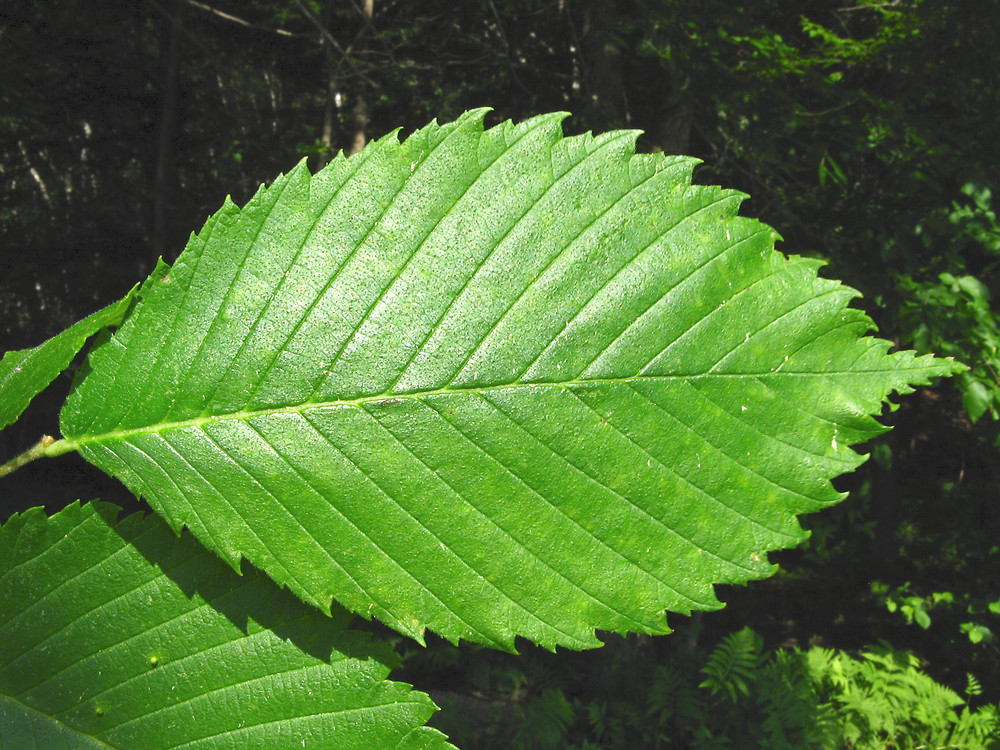 can still see them in my mind’s eye. I loved the smoky aroma when my father burned them. Today burning leaves is more or less illegal everywhere but sixty years ago and more it was one of the great rituals of Fall. Burn leaves today and you go to jail, another bit of imbecility that's been foisted on us.
can still see them in my mind’s eye. I loved the smoky aroma when my father burned them. Today burning leaves is more or less illegal everywhere but sixty years ago and more it was one of the great rituals of Fall. Burn leaves today and you go to jail, another bit of imbecility that's been foisted on us.
Inevitably, as was the case with virtually all these quintessentially American trees it succumbed to “Dutch Elm Disease,” which had been introduced by imported logs in the 1920’s. By the early 1970’s it had spread more or less nationwide and our elm was on its last legs. It was in pitiful condition one year when I was home on leave from the Air Force and I realized its end wasn’t far off. Nor was it: shortly thereafter it fell into the neighbor’s yard, was cut into pieces which were brought back over the fence and left to rot through the ensuing decade. As the trunk pieces crumbled into dust a secret was revealed: embedded in the trunk was a metal gatepost. When the tree was planted in the 1880’s there had been a fence around the stable yard to confine the horse. Of course when my father bought the house in 1946 the horse was long gone, the tree was about 60 years old and over the course of time it had engulfed the long-forgotten gatepost completely.
I understand that new varieties and cultivars of American Elm have been developed that are disease resistant. I hope this is true and that one day the name “Elm Street” will again reflect the truth in American towns. I don’t expect to live to see it happen, alas.
THE KINGSBRIDGE PEAR TREE
In my childhood a pear tree lived precariously on the scrap of lawn behind the house. It was peculiarly misshapen and leaned at an angle away from the house; my father once told me its odd shape was due to his efforts to prune it. Maybe so, but I found that it leaned at enough of an angle that I could climb most of the way up the trunk. (I’m not and have never been much of a climber, but that tree was an exception.)
We had a few squirrels in our back yard; about the only kind of “wildlife” present in the Bronx in those days, and they loved that tree. I enjoyed seeing their antics when the pears were ripe: they’d climb up, grab a pear with their teeth, cut it loose, and run off to eat it somewhere else. Pear trees live a long time—one planted by Peter Stuyvesant in colonial “New Amsterdam” lived to be a more than 100 years old—but that one is now long gone. My father sold the house in 1981 and how long after that the pear tree was removed or died I don’t know, but whenever this happened a part of my early life went with it. Peter Stuyvesant’s tree and my father’s are now merely memories, albeit good ones.
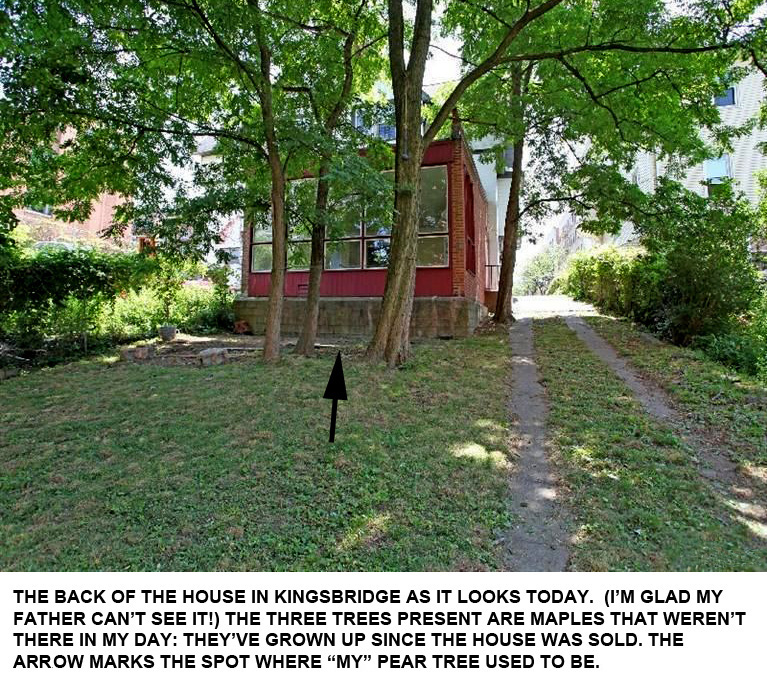
I don’t have a picture of this tree, either, but I do have one of the place where it used to be—a picture swiped from a real estate site showing the house as it is now. The trees in the image shown here are maples that have grown up since the house was turned into a rental property.
TUCKER’S PEAR TREE
As it happens, about 25 years ago I had a chance to plant my own pear tree, which I did sort of in memoriam for the one of my youth. I’d installed a “Doggie Dooley” thing in the yard, a sort of cesspit device in which we were told we could dump dog poop, add water, and have the poop simply 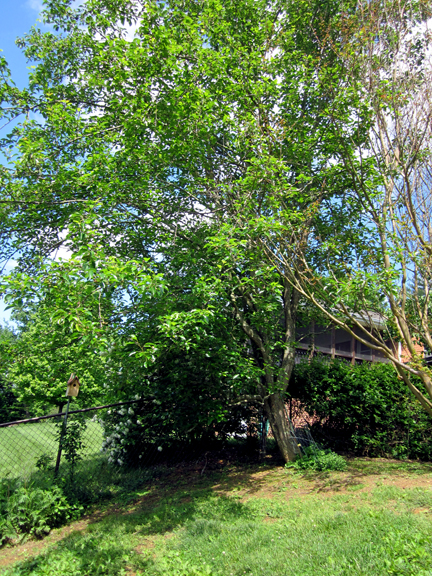 dissolve and be gone. Since we had two big dogs at the time this seemed like a good thing to have, so with considerable effort and a clam-shell post-hole digger, I made a four-foot-deep cavity in which to install the Doggie Dooley.
dissolve and be gone. Since we had two big dogs at the time this seemed like a good thing to have, so with considerable effort and a clam-shell post-hole digger, I made a four-foot-deep cavity in which to install the Doggie Dooley.
There was, however, one big problem: the damned thing didn’t work. Perhaps the soil in our yard didn’t “perk,” (it should have, this was over the old septic field); perhaps the whole thing was a scam; but for whatever reason, the promised miraculous disappearance of the dog poop put into it never happened. Instead the hole filled up with a slurry of liquefied dog poop containing a heavy admixture of Virginia mud. Since the Doggie Dooley proved useless I took it out. I was then faced with the question of what to do with the hole. I’d put in a lot of labor to dig it and was loath to just fill it up again, so instead I planted a sapling pear tree in it. There was just enough left of the original four foot depth to make a perfect depth for the tree, and we reasoned—quite correctly—that there would be plenty of “fertilizer” in it. Boy, were we right: that tree bore fruit the very first Summer it was in the ground and has continued to produce a bumper crop every year. It grows exuberantly: just this past Summer we had to chainsaw nearly half of its branches to prevent it from collapsing the neighbor’s garden pergola. The pears rain onto the ground, attracting deer and other animals, not mention my current pair of dogs, who love raw pears and will happily spend an entire Fall afternoon eating them.
Since the dog who “used” that worthless Doggie Dooley the most was my late beloved mutt, Tucker, we named the tree after him, and have called it “Tucker’s Pear Tree” ever since. I imagine that some of his molecules are in the pears it produces every year. I hope so. It's an odd kind of immortality but if ever anyone deserved immortality, it was Tucker. He was everything a dog should be, and then some.
THE DUTCHESS COUNTY MAPLE
In 1961 my father bought an old farmhouse in Dutchess County New York. Aside from about 50 acres of woods (mostly mature oaks and hickories) there were some big trees quite near the house. One was an enormous maple that had died; my father had it cut down sometime in the mid 1960's so as not to endanger the house if it fell. That huge trunk laid on the lawn for several years until one Fall, both of us having killed our season limit of one deer, my brother-in-law (below) and I decided it was time to split it into firewood. Someone came in with a chain saw and cut it into proper lengths and we set upon the blocks with splitting wedges and mauls.
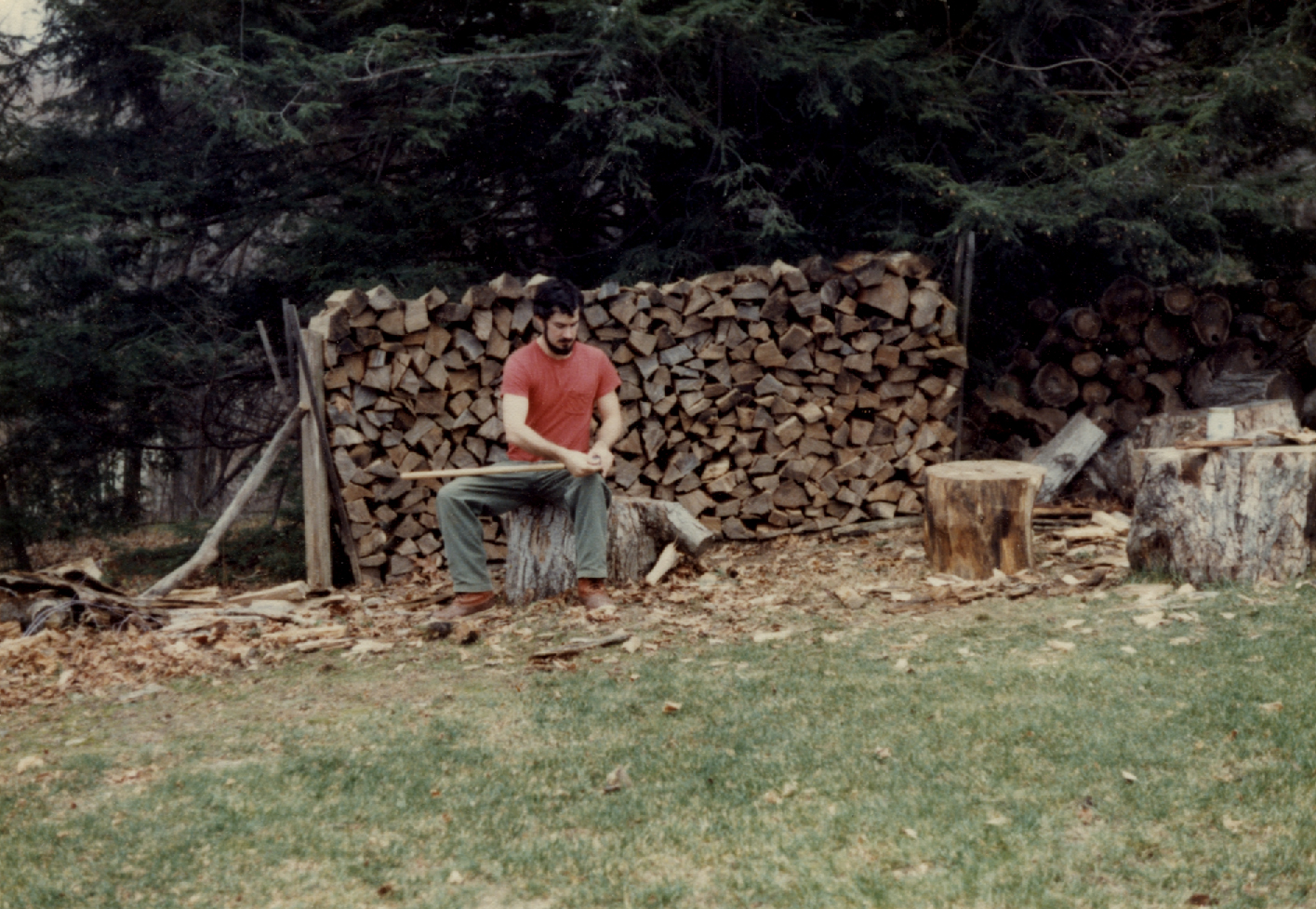
I was new to the game at that time, inexperienced enough to think “How hard can it be?” But after several years of “curing” that maple was rock hard, the most difficult wood to split I have ever encountered. The two of us spent a week hammering at it. It was strenuous work, but I also remember that week as one of the most pleasant I ever spent at the house. It was a whole week of camaraderie, “male bonding” and thorough-going fatigue at the end of each day, but I looked forward to the next session. In the end we got several cords of high-grade firewood cut, split and stacked. Although my father had a fireplace in the house, he never burned a single piece of that tree: he gave the wood to someone who’d done work for him, and that was okay with us. I learned how to split wood, something everyone needs to know but which life in a city can’t teach.
THE MOTHER’S DAY TREE
Not all trees I’ve split were as tough as that maple. One that was easy was what we called “The Mother’s Day Tree,” on a property I used to own in Burr Hill, Virginia in 1981. It was a big red oak that had blown down in a windstorm. On Mother’s Day that year my in-laws came for a visit, and my father in law brought his chain saw with him to buck the tree up into manageable lengths.
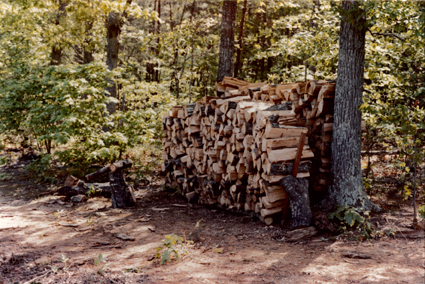 That wood was so easy to split I could almost have done it with a butter knife, let alone an axe or a maul and wedge. I cracked it into firewood quite handily, hauling and stacking several cords of it to use to heat the house in winter. Alas, we left that place in 1982 for my 5-year exile in Texas, and in the end my tenant benefited from my labor. But I still remember the way that tree smelled. Wine connoisseurs sometimes describe a wine as having an “oaky” aroma; The Mother's Day Tree was the absolute epitome of that description. No smell, to my mind, is more pleasant than that of fresh red oak. It evokes a strong memory of a house I loved but owned all too briefly, and the rural way of life I badly wanted but never had for more than a weekend at a time.
That wood was so easy to split I could almost have done it with a butter knife, let alone an axe or a maul and wedge. I cracked it into firewood quite handily, hauling and stacking several cords of it to use to heat the house in winter. Alas, we left that place in 1982 for my 5-year exile in Texas, and in the end my tenant benefited from my labor. But I still remember the way that tree smelled. Wine connoisseurs sometimes describe a wine as having an “oaky” aroma; The Mother's Day Tree was the absolute epitome of that description. No smell, to my mind, is more pleasant than that of fresh red oak. It evokes a strong memory of a house I loved but owned all too briefly, and the rural way of life I badly wanted but never had for more than a weekend at a time.
THE TWO SUGAR MAPLES
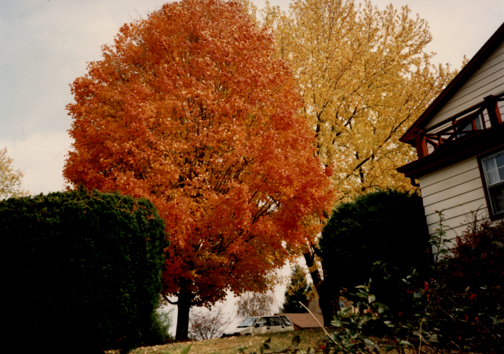 When we moved into our house in 1987 there were two maple trees on the front lawn. One was a silver maple (of which more below) and the other a sugar maple. That latter tree was a delight in the Fall: its leaves would turn to a flaming orange color, glowing more brightly than any other tree. Woodpeckers and sapsuckers loved it, drilling neat holes in the bark to get at the sweet sap and the ants that swarmed around places where the sap flowed out.
When we moved into our house in 1987 there were two maple trees on the front lawn. One was a silver maple (of which more below) and the other a sugar maple. That latter tree was a delight in the Fall: its leaves would turn to a flaming orange color, glowing more brightly than any other tree. Woodpeckers and sapsuckers loved it, drilling neat holes in the bark to get at the sweet sap and the ants that swarmed around places where the sap flowed out.
In February 1994 we had an “ice storm,” that peculiar weather event that takes place when it isn’t cold enough to snow, but cold enough so that freezing rain coats everything with ice. The ice storm went on all night and in the morning every tree and bush was covered with a crystalline sheath that glittered in the sun. It was a remarkably beautiful sight, a glorious fairy landscape in which everything was seemingly encased in pure glass.
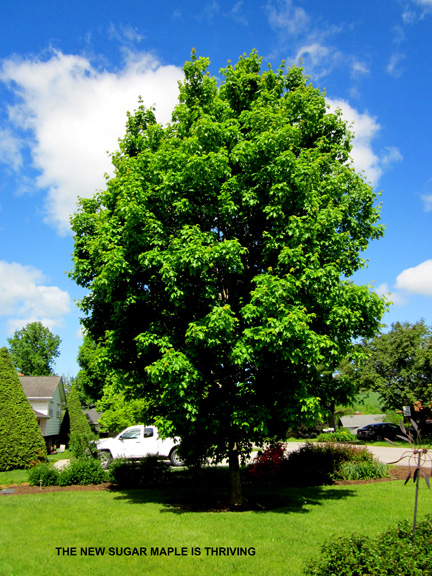 Unfortunately the weight of the ice soon brought disaster: for three days we could hear CRACK! CRACK! CRACK! as tree branches and whole trees fell all over town. One of the casualties was our beautiful sugar maple: it lost several major branches to the ice. It was so badly damaged we were advised to have it cut down, but I didn’t have the heart to do so. It was in truth dead, but it took another 15 years for it to finally give up the ghost. During that 15 years its attraction to birds and squirrels actually increased, as the trunk ran with sap every Spring and cavities where branches had broken off provided places for squirrels to nest.
Unfortunately the weight of the ice soon brought disaster: for three days we could hear CRACK! CRACK! CRACK! as tree branches and whole trees fell all over town. One of the casualties was our beautiful sugar maple: it lost several major branches to the ice. It was so badly damaged we were advised to have it cut down, but I didn’t have the heart to do so. It was in truth dead, but it took another 15 years for it to finally give up the ghost. During that 15 years its attraction to birds and squirrels actually increased, as the trunk ran with sap every Spring and cavities where branches had broken off provided places for squirrels to nest.
But eventually it did die completely and had to be cut down. I did so, splitting the wood—beautiful, straight-grained, pure white wood—for use in our fireplace. I have told this story elsewhere. Instead of doing it by hand I rented a hydraulic log splitter which made short work of the job, even though it seemed disrespectful to turn that lovely tree into firewood. The first sugar maple has since been replaced by another one planted in the same spot. The new one is flourishing and in time, I hope, it will provide the same succor and shelter as its predecessor did. No doubt by then I’ll be dead; but planting any tree is an expression of faith in the future.
THE SILVER MAPLE
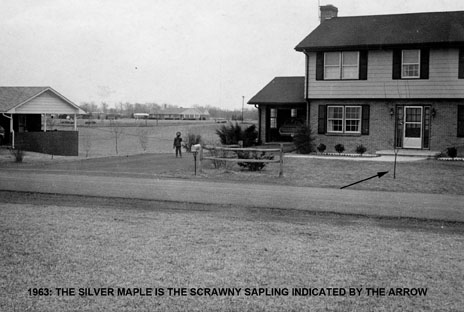
The house I live in was built in 1963. At that time the Federal Home Administration had certain rules for underwriting mortgages, one of which was that new houses had to have a certain number of trees on the lot to qualify. Builders would plant what came to be known as “FHA trees,” of course choosing the least expensive and most readily available species. In Blacksburg these seemed always to be white pines or silver maples. Our lawn was graced with a silver maple. We have a picture of the house in its early days, showing this tree as a mere sapling a couple of inches in diameter; but in 1987 it was easily three feet across at the base and well over 30 feet high, despite being only 24 years in the ground.
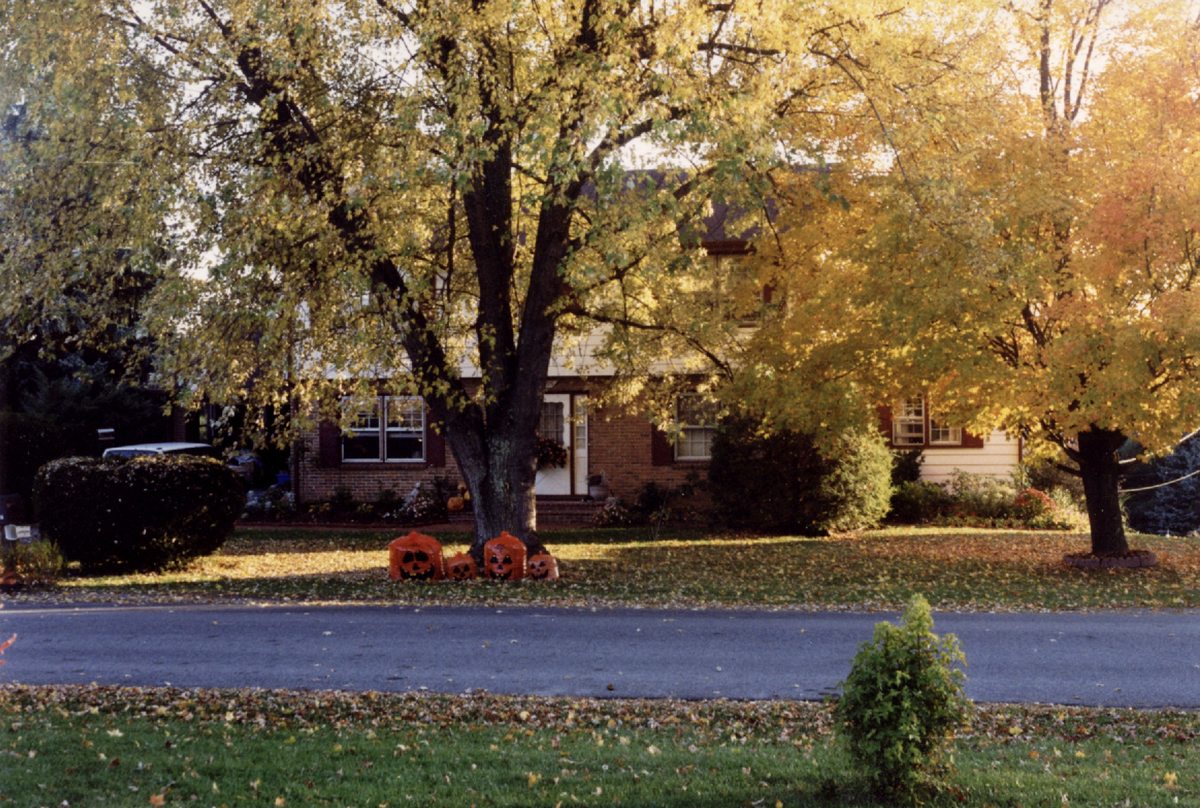
Silver maples are structurally weak; The Great Ice Storm of 1994 hit this tree even harder than it had hit the sugar maple. On the day the storm started (February 10th) we’d brought home a brand new Volvo station wagon, and parked it in our driveway: the next morning as we were admiring the view of the ice-bound trees, my wife said, “Maybe you’d better move the Volvo.” I did, and 20 minutes late, CRASH! Down came a limb of that silver maple that was bigger than the entire sugar maple: it landed right where the new car had been. Had I not moved the car it would have been crushed.
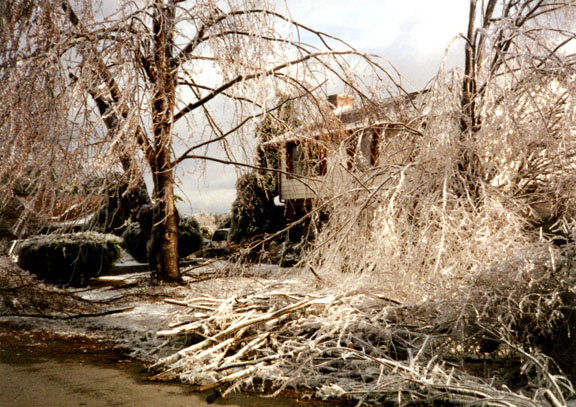
Other falling limbs destroyed our mailbox and some smaller shrubs. I wanted to save the silver maple, so we had someone come and “stub off” the broken branches and install a cable to keep the separate trunks from splitting further. That worked after a fashion and the tree hung on for several years, but eventually it was obvious that it had to go. Removing it was what is colloquially called “a hell of a job,” but we have an outstanding arborist in Blacksburg who took it down in pieces and carried it away to wherever dead trees go to rot. Then he arranged to have the stump taken out.
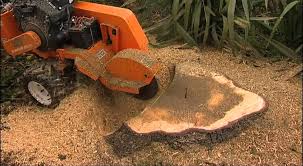 The fastest, easiest, and scariest way to remove a tree stump (short of using dynamite, which wasn’t an option) is a machine called a “stump grinder.” Stump grinders do exactly that. There’s what amounts to a gigantic buzz-saw on the front that the operator can apply to the stump, reducing it to a pile of chippings. This stuff made decent mulch, so we had him grind not only the part protruding from the surface, but well down into the ground about a couple of feet. That made a very nice base for the flower garden Mrs Outdoorsman had long yearned for, and which in the ensuing years has become a neighborhood traffic-stopper. She’s very proud of it and rightly so. I imagine the silver maple would be too, if it could know that it finally had real value as an “ornamental” even if only underground.
The fastest, easiest, and scariest way to remove a tree stump (short of using dynamite, which wasn’t an option) is a machine called a “stump grinder.” Stump grinders do exactly that. There’s what amounts to a gigantic buzz-saw on the front that the operator can apply to the stump, reducing it to a pile of chippings. This stuff made decent mulch, so we had him grind not only the part protruding from the surface, but well down into the ground about a couple of feet. That made a very nice base for the flower garden Mrs Outdoorsman had long yearned for, and which in the ensuing years has become a neighborhood traffic-stopper. She’s very proud of it and rightly so. I imagine the silver maple would be too, if it could know that it finally had real value as an “ornamental” even if only underground.
Sometimes a loss becomes a gain. One of our neighbors took a chunk of that silver maple and spirited it away. Of course we didn't mind, in fact we didn't even know about it until some months later he presented us with a beautiful hand-turned bowl made from the wood of our defunct tree. So a bit of the silver maple lives on, and serves as proof of cordial relations.
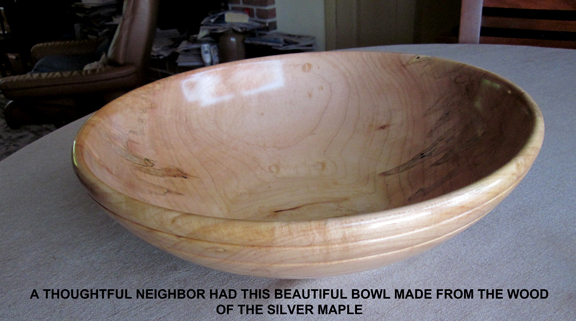
THE CURSED WHITE PINES
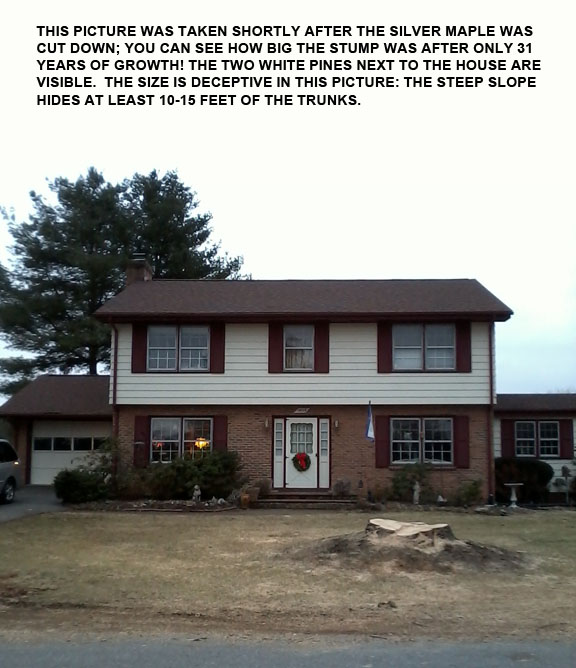
One of the acceptable FHA tree species is the white pine, a true “trash tree” if ever there was one. White pines are abundant in our neighborhood, all of the houses being built at roughly the same period by one or two local builders. When we moved in, we had at least 20 of these trees on our lot. White pines grow very tall: by 1987 when we came all of them were well over 60 feet, and most closer to 80 feet. Two were very close to the house, and 17 of them were planted along the 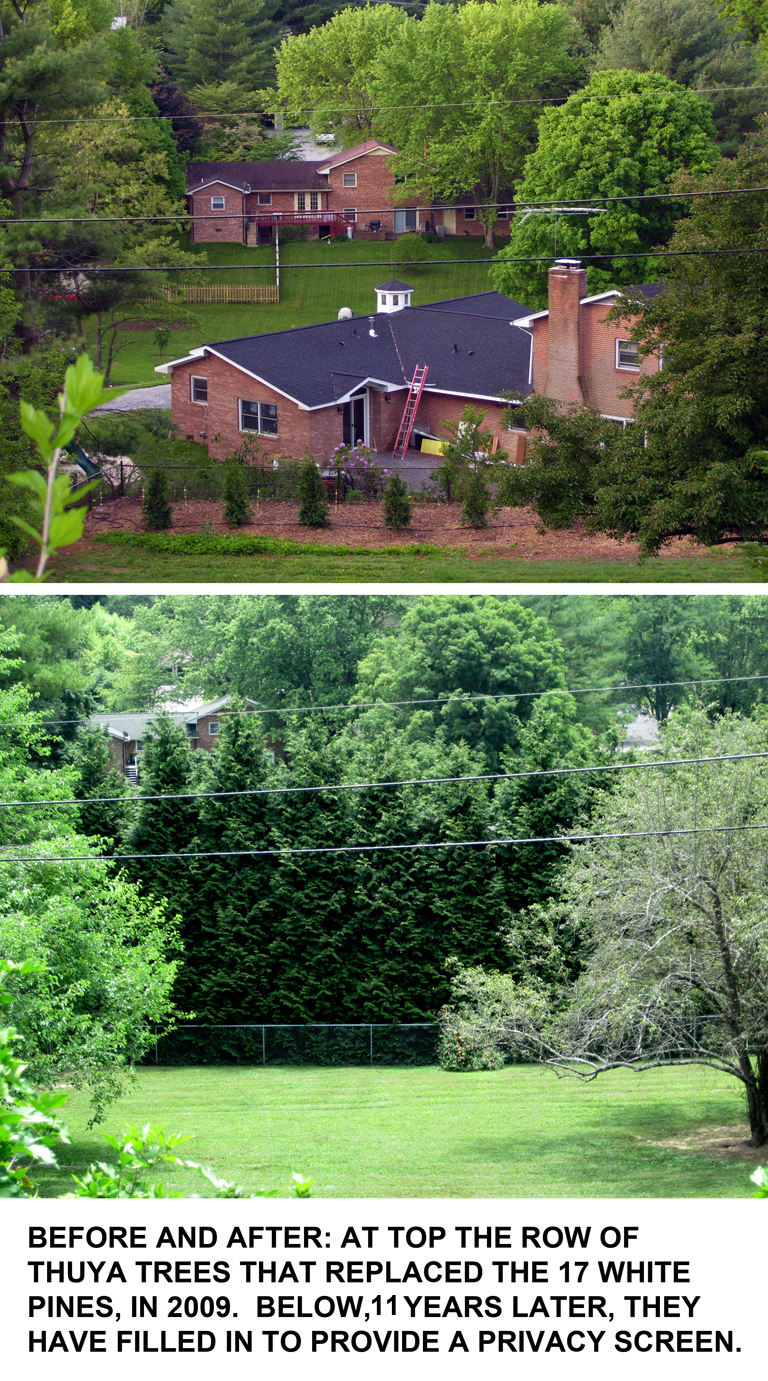 back property line. One day there was a windstorm. My neighbors across the road had a white pine fall down, fortunately doing no damage, which it might well have done. That decided the fate of most of ours, especially the 17 along the back property line: they had to go.
back property line. One day there was a windstorm. My neighbors across the road had a white pine fall down, fortunately doing no damage, which it might well have done. That decided the fate of most of ours, especially the 17 along the back property line: they had to go.
Now, removing a tree that’s 80+ feet tall is a very risky and delicate undertaking, especially when there’s a chance (a good chance) it might fall on the neighbor’s house. Luckily the arborist we use is very skilled, but we still needed to make some preparations. One of these involved taking down a considerable segment of our boundary fence so he could get his bucket truck in, which also involved getting consent from our next door neighbor to allow the truck through his yard. We had dogs, so we had a local fencing company put up a temporary fence closer to the house so they could be let out without danger. Removal took about 10 days. The arborist is a real artist: all those monstrous trees were taken down pretty much intact and the logs sold off to someone who presumably took them to a pulp mill, white pines not being very useful for anything else. The fence was re-installed, the temporary fence taken down, and then we needed to replace the trees.
It happened that somewhat earlier we’d lost a couple of beautiful blue spruce trees to wind damage: they had been removed and replaced with Leland Cypress trees. But the cypresses proved a disappointment so that the chosen replacements for the white pines were instead Giant Thuyas. These are (so far) well-behaved evergreens that don’t grow nearly so tall as a white pine. They get to be about 25-30 feet and they fill out nicely to form a privacy screen. Seventeen of them: on top of the removal process, the total bill was staggeringly high but we gained substantial peace of mind and privacy even as we depleted our bank balance.
Nevertheless we weren’t done with white pines, not by a long shot. I mentioned that there were two of them next to the house, which you can see in the image above. One was inside the fence and one outside. Those were so close that if one fell, the house was going to get hit very badly, so we issued a death warrant for them, too. Getting that pair out was even more complicated than removing the ones in the back because that side of the lot is very steep, the spot they were in is very narrow, and the fence interfered with the process. But our amazing arborist climbed those trees and lopped them off in pieces that would likely have weighed close to half a ton apiece, lowered them to the ground, and hauled them away. It wasn’t a cheap job but it had to be done.
In the place where one of those pines had grown we had the stump removed and in its place we planted a Serbian Spruce. A nice tree, I suppose, but we can hardly see it where it is. It's one of those trees that will serve its purpose without fuss or bother, and which will be forgotten, like so many of us; including me, whether or not I've served some sort of purpose.
THE MULBERRY
Some trees are “volunteers.” They just sort of spring up by themselves. One species adept at this is the mulberry: birds who eat the fruit of this tree “plant” it in other locations via their droppings. A mulberry tree “jest growed” in the line of our boundary fence, a mulberry that reached astonishing size in only a few years, at most 15: this image was made in August of 2019.
Mulberries are beloved of any number of species, including various birds and squirrels. I enjoyed watching squirrels comb this tree for fruit in season: at times I’ve seen as many as half a dozen jumping around and chowing down on the fruit. The berries are perfectly edible for humans too: one year our neighbor’s teenage daughters asked if it would be all right if they picked some to eat, as branches extended over the fence into their yard. Of course we agreed.
The birds who planted it had no regard for safety considerations, obviously: they parked it immediately under a power line! As it grew its branches came to engulf the line, with predictable results. A year before this essay was written we saw smoke and heard “sizzling” noises where the branches touched the line (most people don’t know it but overhead power lines aren’t insulated) so we called 911, who alerted the local power company. A man was sent to look, and he agreed, yep, the tree was a problem, we’ll have it taken out, thank you very much for letting us know.
A year went by. This month, nearly a year to the day after the first call, the same thing happened, but this time we saw actual flames! It presented no danger to our house, but there’s a large white pine close by, and I was concerned it would set that tree on fire, which would in turn burn down the house behind us in all likelihood. This would not be a good thing. We exercised “due diligence,” called 911 again, who sent a fire crew, who assured us they would alert the power company. They did.
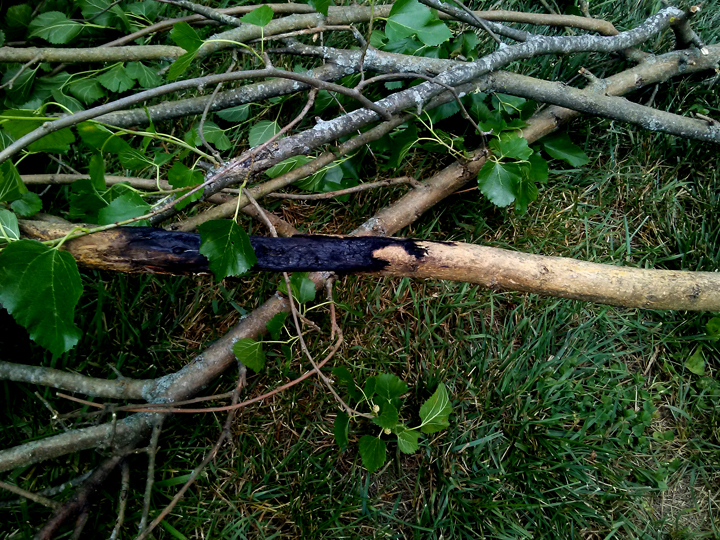
A power company representative came and yes, sir, that tree is a danger, we’ll have to take it down. I pointed out that they were supposed to have done that a year before; I expect that embarrassed the company enough that they did indeed send a tree crew the next day to deal with the issue. It took two days to deal with the mulberry and the apple tree (see below) that also had the power line running through it. Because everything was behind a fence there was no way to get a truck into the yard; it was all done with long limbing poles and climbers using chain saws. There was one hell of a brush pile, but in fact they didn’t take either tree down completely, just the parts that “interfered” with the power line.
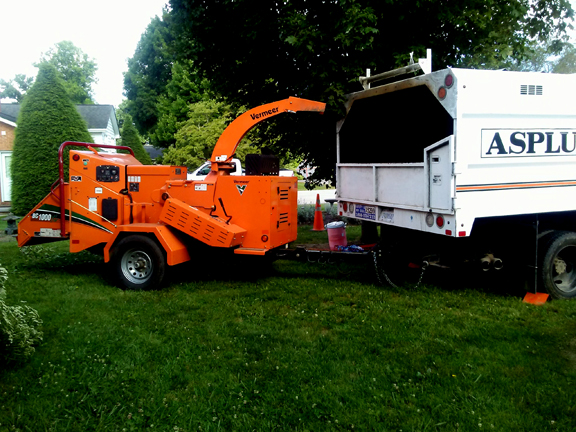
I was told they “…only chip the wood when a tree falls on the line…” but in my case I showed them the consent agreement and work order from a year before that plainly stated, “Chip all wood,” so the next day they returned with a chipper truck. That chipper is one scary piece of equipment, in many ways scarier than the stump grinder. Nor is this one the biggest they have: there's one twice its size they use for really tough jobs. This one will "only" do logs about 6" in diameter. God alone knows what they do with the mulch. The crew chief told me that a lot of people want it and it’s free for the asking, but by golly, I have had enough mulch to last what remains of my life and want no part of it. They took the stuff away to The Great Mulch Pile In The Back Of Beyond, where someone else can have it with my blessing.
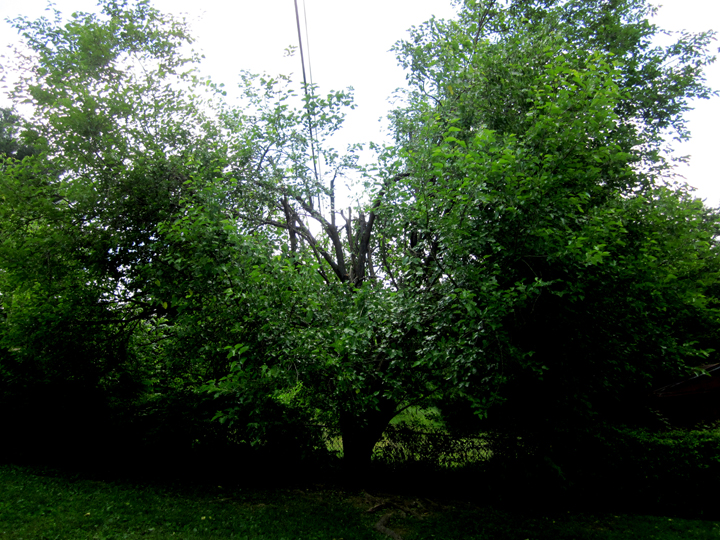
I’m glad they left so much of the mulberry in place, even though it's now lopsided and funny-looking. The squirrels will no doubt be happy too. Even though it's mutilated and Mrs Outdoorsman isn’t happy about that, no doubt it will fill in given time. Trees and other vegetation do heal themselves, better than wounded or mutilated humans do. Maybe we could learn something from them.
THE APPLE TREE
Concurrent with the mulberry’s “trimming” we had to have a very large apple tree done for the same reason: hot electric wires running through the branches. I wasn’t happy about that because that apple tree is certainly 50 years old, maybe more, and serves as a source of food for many species, including not just squirrels, but for our dogs. Over the 33 years we’ve been in this house all of our dogs have loved to lie out on the grass eating windfalls.
We never bother to pick the apples—I have an agreement with Kroger’s whereby I give them money and they give me apples whenever I want—and in truth its fruit isn't very flavorful. But besides the dogs the local deer love them and from time to time come into our yard, leaping the fence to get at them in the middle of the night. When Mrs Outdoorsman expressed skepticism that this could happen I set up a game camera that captured the image of three does and a 12-point buck under the tree, contentedly munching away! Although we never pick the apples ourselves one year a few of my veterinary students asked if they could do so, and of course we were happy to have them do it. One of the girls even made us a pie!
I regret to say that the apple tree was mutilated even worse than the mulberry; pretty much half of it is gone now. As apple trees will do, it will send up sprouts and given enough time it will “fill in,” but it’s pretty sad-looking right now. My dogs and the deer and the squirrels will have to be content with far fewer delicacies. Mrs Outdoorsman has long wished to get that tree out of the yard, but damn it, it hurts to lose it. It’s been there a very, very long time and served as sustenance and succor for so many animals it’s almost a crime to kill it.
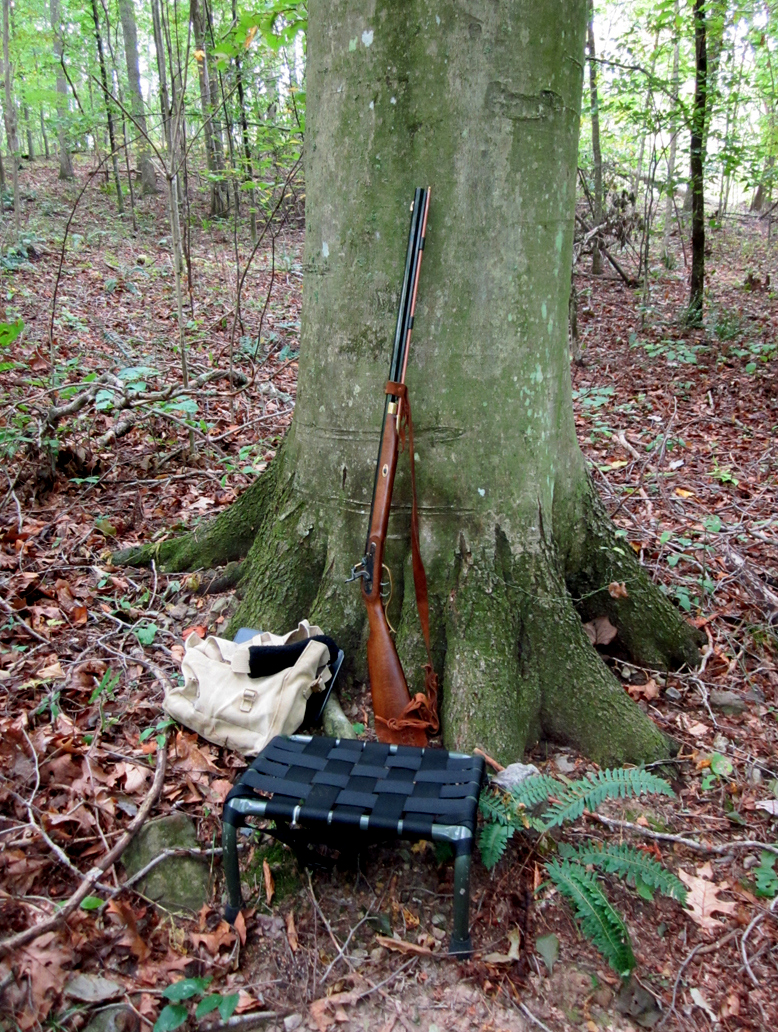 THE BEECH TREE
THE BEECH TREE
There have been other trees with personal significance. One is The Beech Tree. It marks a specific spot where I’ve hunted for many years: a very large and reassuring tree, where I’ve spent hours watching and waiting for game to come by. I can find it in the dark in the woods without fail. Sitting against it I’ve made some kills but that’s not why I care about it. In its shadow I’ve spent hours dozing, meditating, and generally being able to forget the stresses of life for at least a few hours at a time. Most of the trees that have been important symbols and touchstones in my life are gone but The Beech Tree is still here, the sort of place everyone needs. The Beech Tree is an escape valve.
When the time comes—and it is surely coming—that I can no longer negotiate the hike into the woods, or when my eyesight fails and I can’t find The Beech Tree, or—God forbid—it dies or is cut down, it will be like losing another old friend. Then, like the Kingsbridge Elm and the Kingsbridge Pear Tree, it will exist only in memory, until my memory is gone as well. I hope, though that The Beech Tree will continue to live for many many years after I’m gone.
Of all the trees that were in our yard when we moved in, only two are left; one of them is the apple tree that isn't long for this world anyway. I mourn for all of these trees and more. As is true of humans trees are mortal beings, and as is true of every man the end of a tree is foreordained. Whether it's burned as firewood, made into furniture, or left to rot where it falls its loss is a diminution of the world's substance, something which can't always be said of a man.
But if trees have taught me nothing else, it is this truth: sooner or later, you lose everything you love.
|SEASON LOGS |
| HUNTING | GUNS | DOGS |
| FISHING & BOATING | TRIP REPORTS | MISCELLANEOUS ESSAYS |
| CONTRIBUTIONS FROM OTHER WRITERS|
| RECIPES |POLITICS |